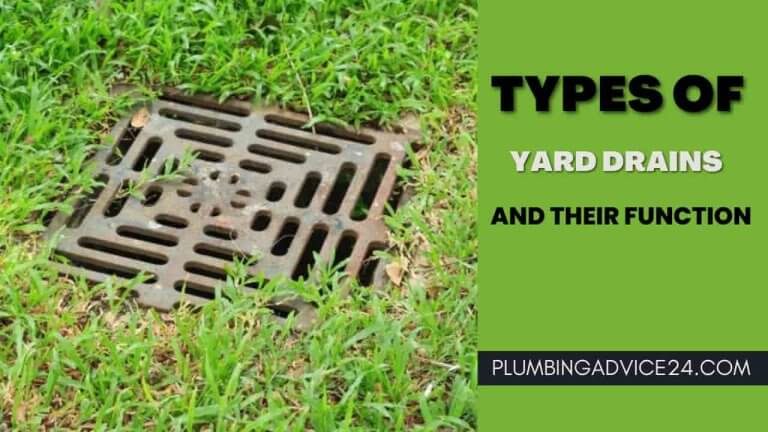Types of Copper Pipes | Copper Pipe Size
Friends, we learned about different types of pipes. But the pipe we learned about was very little. So we will learn about those pipes in more detail. You may know about copper plumbing; you all must have seen it. We will know What copper pipe is and How many types of copper pipes are in this chapter.
Furthermore, you should read this article to learn about the uses of copper pipes, their advantages and disadvantages, their prices, and their installation cost.
let’s move on to chapter,
What Is a Copper Pipe?
Copper pipe is a traditional form of plumbing piping. These pipes have been a staple in the plumbing industry for decades and are used in homes as water supply lines. Copper plumbing pipes can last for many years and are found in sinks, showers, tubs, and other fixtures in new and old homes.
Copper pipes remain equally popular with plumbers and homeowners because they are best suited to protect water quality and are corrosion-resistant. It can control high water pressure, is able to tolerate both hot and cold water temperatures, and can also be recycled, making it an environmentally friendly option.
Must Read : What Is Plumbing Pipe | 22 Different Types of Plumbing pipes
How Many Types of Copper Pipes?
A rigid copper pipe is best for water supply, as it does not come with any health risks. There are also rigid copper pipes and flexible varieties. It comes in four wall thicknesses. There are four copper pipe types.
There four different types of copper pipes are as below,
- Type K
- Type L
- Type M
- DWV Pipes
So let’s learn more about copper pipe types,
1. Type K Copper Pipe
Of all the types of copper pipe, type K walls are the thickest. Type K becomes the heaviest and most expensive type of copper pipe due to its thickness. Because it is more expensive than other types of copper pipes, those pipes will look less under your sink or with other plumbing fixtures.
These thicknesses lend themselves to use in commercial plumbing, HVAC, and sprinkler systems but are commonly found in main groundwater installations, as thin pipes may erode or break underground, but the durability of this type of pipe lasts longer. Country, so it does not have to dig every few years.
2. Type L Copper Pipe
Although not as thick as the Type K, it is still quite durable and can be used in many ways. Type L copper pipe is capable of being used in underground applications but is more commonly used to replace or repair water lines.
Type L copper pipe is often preferred if the house is known to have a water problem like hard water because hard water will not pass through thick walls as easily as through type L pipe.
These copper pipes, marked in blue, come in both flexible rolls and rigid tubing. Rigid tubes are commonly used for indoor water piping, while flexible rolls are used for underground and outdoor plumbing.
3. Type M Copper Pipe
Type M has a thinner wall than both Type K and Type L copper pipes. The Type M copper pipe has less copper, so it is lighter and less rigid, making it easier to work with. At best, they are less expensive than other types.
Marked in Type M red, these pipes come in both flexible roll and rigid tubing. It is not used in outdoor underground applications. These pipes are very fit and very durable, so a type M copper pipe is a good option if you want to run your home water system.
Its affordable price makes it one of the most popular copper pipes for domestic water systems. In some areas, Type M copper pipes are not allowed to deliver potable water. But it can also be used for hot water heating systems.
4. DWV Pipes
Copper DWV (Drain, Waste, and Vent) Pipes are pipes that are used to remove waterborne waste from your property. This pipe is only allowed for use in drain and vent lines. As the only type of copper pipe used in the water system, the DWV pipe is an “odd man out.”
Unlike a water supply line that needs to use pressure to deliver water, DWV pipes use gravity to work. This application is suitable for DWV copper pipes.
Copper DWV pipes are larger in diameter than other types of copper and have yellow markings. It has the thinnest walls of other types of copper pipe. The wall thickness for a 2-inch pipe is 0.042, which is the smallest diameter available for DWV.
It is mostly found in older homes, but if you have a new home, you will not find DWV copper pipes in your drain or vent line; they are all replaced by PVC pipes in new construction.
Must Read : Types of PVC Pipe | What Is the Difference Between Schedule 40 and Schedule 80
Copper Pipe Cost
Copper is the most expensive piping material among other plumbing pipes available. While copper piping is durable and rigid, which increases its cost. Copper pipes are still becoming more expensive, as copper is becoming more expensive.
Copper pipe prices are between $2.00/ft to $5.70/ft. If you want to rebuild your home, you will have to pay around $5,000 to $20,000 for these pipes.
Must Read : How to Install Copper Pipes | 4 Ways to Repair Copper Pipe
How to Measure Copper Pipe Size?
If you are replacing or adding new pipes, there are a few things to consider before deciding which type of copper and pipe to use.
Start by considering the function of the pipes and what devices they need to be connected to. Figure your appliance fixture unit in your local building code. A fixture unit is a rating that determines how much water you need to supply, which will determine the size of the pipe needed.
The nominal pipe size of copper pipe is always 1/8 inch less than the actual outside diameter. If for some reason, the pipe size is not written on the pipe, you can use the string method to find it.
Follow the below steps to measure copper pipe by string method.
- Find the circumference of the pipe by wrapping the string around the pipe once. Mark the section of the string where it begins to overlap.
- Measure the length of the string wrapped around the pipe with a ruler.
- Divide the length by 3.143, and this is the outside diameter of your pipe.
- To find the NPS, you simply subtract 1/8 inch (or 0.125 inches) from the outside diameter of the pipe.
After finding the nominal pipe size, you should use the copper pipe size chart or copper tube size chart below.
Following is the copper pipe dimension chart:
Copper Pipe Size Chart
| Nominal Pipe Size (inch) | Type K Copper Diameter (inch) | Type L Copper Diameter (inch) | Type M Copper Diameter (inch) | Pipe Sizing Criteria | ||||||
| Velocity Ft/sec | Loss in PD’/100′ | Flow GMP | ||||||||
| Outside | Inside | Outside | Inside | Outside | Inside | |||||
| 0.25 | 0.375 | 0.305 | 0.375 | 0.315 | ||||||
| 0.38 | 0.5 | 0.402 | 0.5 | 0.43 | 0.5 | 0.45 | 1.0 | 3 | 0.5 | |
| 0.50 | 0.625 | 0.527 | 0.625 | 0.545 | 0.625 | 0.569 | 1.5 | 3 | 1 | |
| 0.75 | 0.875 | 0.745 | 0.875 | 0.785 | 0.875 | 0.811 | 2.0 | 3 | 3 | |
| 1.00 | 1.125 | 0.995 | 1.125 | 1.025 | 1.125 | 1.055 | 2.5 | 3 | 7 | |
| 1.25 | 1.375 | 1.245 | 1.375 | 1.265 | 1.375 | 1.291 | 3.0 | 3 | 12 | |
| 1.50 | 1.625 | 1.481 | 1.625 | 1.505 | 1.625 | 1.527 | 3.5 | 3 | 17 | |
| 2.00 | 2.125 | 1.959 | 2.125 | 1.985 | 2.125 | 2.009 | 4.0 | 3 | 35 | |
| 2.50 | 2.625 | 2.435 | 2.625 | 2.465 | 2.625 | 2.495 | 4.5 | 3 | 70 | |
| 3.00 | 3.125 | 2.907 | 3.125 | 2.945 | 3.125 | 2.981 | 5.0 | 3 | 110 | |
| 3.50 | 3.625 | 3.385 | 3.625 | 3.425 | 3.625 | 3.459 | 5.5 | 3 | 160 | |
| 4.00 | 4.125 | 3.857 | 4.125 | 3.905 | 4.125 | 3.935 | 6.0 | 2.5 | 225 | |
| 5.00 | 5.125 | 4.805 | 5.125 | 4.875 | 5.125 | 4.907 | 6.5 | 2.5 | 380 | |
| 6.00 | 6.125 | 5.741 | 6.125 | 5.845 | 6.125 | 5.881 | 7.0 | 2.2 | 575 | |
| 8.00 | 8.125 | 7.583 | 8.125 | 7.725 | 8.125 | 7.785 | 7.5 | 1.9 | 1105 | |
| 10.00 | 10.125 | 9.449 | 10.125 | 9.625 | 10.125 | 9.701 | 8.0 | 1.5 | 1835 | |
| 12.00 | 12.125 | 11.315 | 12.125 | 11.565 | 12.125 | 11.617 | 8.5 | 1 | 2800 | |
Must Read : What Is Steel Pipe | Steel Pipe Applications | How to Measure Steel Pipe | Steel Pipe Cost
Advantages of Copper Pipe
- Copper plumbing pipes are durable.
- Since copper is a lightweight metal, copper pipes can be bent easily.
- The copper pipe does not contaminate the water.
- It can withstand both hot and cold water.
- It is also capable of recycling, so it is less harmful to the environment.
- Copper pipes are fire-resistant.
Disadvantages of Copper Pipe
- Plumbers cannot use copper pipes in tight spaces, as these pipes are too stiff.
- It is also the most expensive type of plumbing pipe. The cost of any project involving copper pipes is also on the rise due to the continuous rise in copper prices.
- Due to the solder connection in the copper pipe, it is difficult to work with it manually.
- Copper pipes cannot withstand acidic water.
- In copper pLumbing, if the water freezes, there is a possibility that the pipe may rupture.
Must Read : Types of Metal Pipes | Seamless Vs Welded Pipes
What Is the Life Span of Copper Plumbing?
Copper plumbing, if properly installed, can last at least 50 years. However, if you take proper care of your pipes, they can last up to 60 or even 70 years. Problems like pinhole leaks, corrosion, and dirty piping can shorten the lifespan of your plumbing, so if you notice any such problem, deal with it immediately.
How to Clean Copper Pipe Corrosion?
Copper plumbing pipe corrosion to clean; you can install a calcite neutralizer tank or a phosphate feeder. Calcite Neutralizer is able to cope with your pH problems, adjusting the pH level of water to a less acidic nature.
The phosphate feeder coats the piping with a protective layer, which helps it with external damage. It is an excellent choice for reducing external corrosion issues.
What Type of Copper Pipe Is Used for Plumbing?
For household wall plumbing, in general walls, type M is more simple and more convenient. While you need strength and protection, it is advisable to use type L . DWV copper pipe is suitable if you are going to use it for a drain or vent.
What Type of Solder for Copper Pipe?
Solder with lead is still available, but lead can leach into your water supply and damage your health, so don’t use it. Buy lead-free solder designed for copper water pipes; you will find it in the store’s plumbing section.
If You Liked This Post? So Share It with Your Friends
Suggested Articles:
- What Is a PVC Pipe | How to Measure PVC Pipe Size | PVC Pipe Installation Cost
- What is PEX Pipe | PEX Pipe Used | How to Measure PEX Pipe | PEX Pipe Installation Cost
- What Is Brass Pipe | Brass Pipe Used For | How to Measure Brass Pipes | Brass Pipe Cost
- What Is ABS Pipe | Why Is ABS Pipe Prohibited | ABS Pipe Installation Cost
- What is CPVC Pipe | CPVC Pipe Manufacturing Process | CPVC Pipe Applications | CPVC Pipe Cost
- What Is uPVC Pipe | uPVC Pipe Manufacturing Process | uPVC Pipe Applications | uPVC Pipe Cost
- What Is PE Pipe | Poly Pipe Manufacturing Process | PE Pipe Applications | Polyethylene Pipe Cost
















